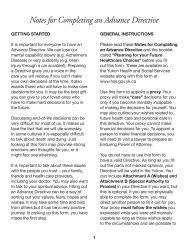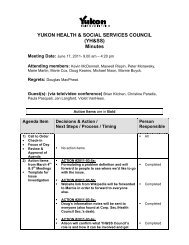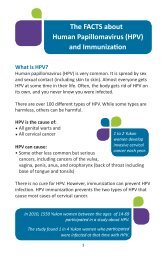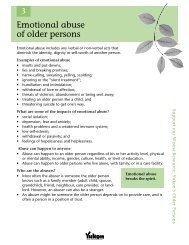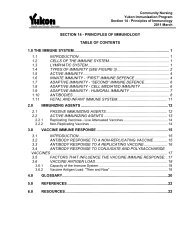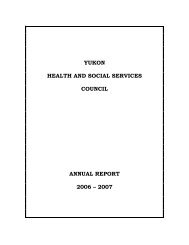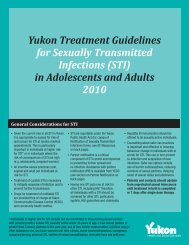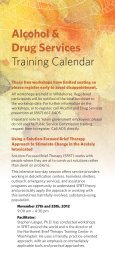Yukon Rabies Risk Management - Guidelines - Health and Social ...
Yukon Rabies Risk Management - Guidelines - Health and Social ...
Yukon Rabies Risk Management - Guidelines - Health and Social ...
You also want an ePaper? Increase the reach of your titles
YUMPU automatically turns print PDFs into web optimized ePapers that Google loves.
<strong>Rabies</strong> <strong>Risk</strong> Investigation Form A Rationale for Public <strong>Health</strong> Implications<br />
Note: Only the questions specifi c to public health responsibility are included in this section. Refer to the YCDC <strong>and</strong><br />
CMOH Tab for questions related to RPEP decision making.<br />
Question 1: Where did the exposure occur?<br />
EHS is responsible for mitigating risks to public health within <strong>Yukon</strong> only, so it is important to consider the location<br />
of exposure. It is the responsibility of YCDC <strong>and</strong> the CMOH to follow up on potential rabies exposures that occur<br />
outside of <strong>Yukon</strong>.<br />
Question 4: Type of animal involved?<br />
Certain species of animals are more likely to carry the rabies virus. In <strong>Yukon</strong>, these include:<br />
domestic animals, such as dogs, cats, ferrets <strong>and</strong> livestock; <strong>and</strong><br />
wild animals, such as bats, arctic fox, red fox <strong>and</strong> any wild carnivore.<br />
If the animal involved is wild, the risk of rabies is considered to be higher. Additionally, exposure incidents involving<br />
stray (i.e., feral) domestic animals are also considered higher risk for rabies.<br />
For domestic animals that are indoor pets only, the risk of rabies is lower because there would be few opportunities<br />
for the animals to interact with other animals, either domestic or wild. It should be noted that animals such as<br />
rodents, small caged pets, rabbits, squirrels, moles, muskrats, shrews <strong>and</strong> voles are not considered likely to carry<br />
rabies <strong>and</strong>, therefore, contact with these types of animals is not considered a risk.<br />
Question 5: If a domestic animal, is the identity of the owner known?<br />
Identifying the owner of a domestic animal is important for gathering information (for subsequent questions) <strong>and</strong>, if<br />
necessary, implementing <strong>and</strong> maintaining an animal management strategy.<br />
While unfortunate, failure to identify the owner of a domestic animal is interpreted to mean that the risk of rabies is<br />
unknown. In these cases, mitigating of a risk to public health is based on the premise that it’s best to err on the side<br />
of caution.<br />
Question 6: If a domestic animal, is it vaccinated against rabies?<br />
The vaccination status of a domestic animal is important because it identifi es the level of risk the animal poses for<br />
the transmission of rabies. Animals that have been vaccinated against rabies within the last year, or vaccinated with<br />
a three-year vaccine, are considered low risk for the transmission of rabies.<br />
Animals that have not been vaccinated, or have an out-of-date vaccination, are considered higher risk for the<br />
transmission of rabies. The animal should be isolated <strong>and</strong> observed for 10 days or until further direction from the<br />
Chief Veterinarian Offi cer.<br />
6<br />
ENVIRONMENTAL HEALTH SERVICES GUIDELINES | October 2011




![Women and Alcohol: A women's health resource [2326.26 KB ]](https://img.yumpu.com/22340649/1/190x245/women-and-alcohol-a-womens-health-resource-232626-kb-.jpg?quality=85)
